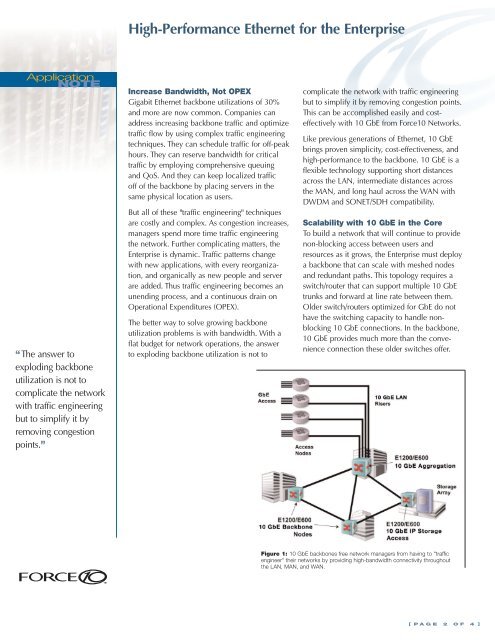High-Performance Ethernet for the Enterprise - Force10 Networks
High-Performance Ethernet for the Enterprise - Force10 Networks
High-Performance Ethernet for the Enterprise - Force10 Networks
Create successful ePaper yourself
Turn your PDF publications into a flip-book with our unique Google optimized e-Paper software.
<strong>High</strong>-<strong>Per<strong>for</strong>mance</strong> <strong>E<strong>the</strong>rnet</strong> <strong>for</strong> <strong>the</strong> <strong>Enterprise</strong><br />
Application<br />
NOTE<br />
“The answer to<br />
exploding backbone<br />
utilization is not to<br />
complicate <strong>the</strong> network<br />
with traffic engineering<br />
but to simplify it by<br />
removing congestion<br />
points.”<br />
Increase Bandwidth, Not OPEX<br />
Gigabit <strong>E<strong>the</strong>rnet</strong> backbone utilizations of 30%<br />
and more are now common. Companies can<br />
address increasing backbone traffic and optimize<br />
traffic flow by using complex traffic engineering<br />
techniques. They can schedule traffic <strong>for</strong> off-peak<br />
hours. They can reserve bandwidth <strong>for</strong> critical<br />
traffic by employing comprehensive queuing<br />
and QoS. And <strong>the</strong>y can keep localized traffic<br />
off of <strong>the</strong> backbone by placing servers in <strong>the</strong><br />
same physical location as users.<br />
But all of <strong>the</strong>se "traffic engineering" techniques<br />
are costly and complex. As congestion increases,<br />
managers spend more time traffic engineering<br />
<strong>the</strong> network. Fur<strong>the</strong>r complicating matters, <strong>the</strong><br />
<strong>Enterprise</strong> is dynamic. Traffic patterns change<br />
with new applications, with every reorganization,<br />
and organically as new people and server<br />
are added. Thus traffic engineering becomes an<br />
unending process, and a continuous drain on<br />
Operational Expenditures (OPEX).<br />
The better way to solve growing backbone<br />
utilization problems is with bandwidth. With a<br />
flat budget <strong>for</strong> network operations, <strong>the</strong> answer<br />
to exploding backbone utilization is not to<br />
complicate <strong>the</strong> network with traffic engineering<br />
but to simplify it by removing congestion points.<br />
This can be accomplished easily and costeffectively<br />
with 10 GbE from <strong>Force10</strong> <strong>Networks</strong>.<br />
Like previous generations of <strong>E<strong>the</strong>rnet</strong>, 10 GbE<br />
brings proven simplicity, cost-effectiveness, and<br />
high-per<strong>for</strong>mance to <strong>the</strong> backbone. 10 GbE is a<br />
flexible technology supporting short distances<br />
across <strong>the</strong> LAN, intermediate distances across<br />
<strong>the</strong> MAN, and long haul across <strong>the</strong> WAN with<br />
DWDM and SONET/SDH compatibility.<br />
Scalability with 10 GbE in <strong>the</strong> Core<br />
To build a network that will continue to provide<br />
non-blocking access between users and<br />
resources as it grows, <strong>the</strong> <strong>Enterprise</strong> must deploy<br />
a backbone that can scale with meshed nodes<br />
and redundant paths. This topology requires a<br />
switch/router that can support multiple 10 GbE<br />
trunks and <strong>for</strong>ward at line rate between <strong>the</strong>m.<br />
Older switch/routers optimized <strong>for</strong> GbE do not<br />
have <strong>the</strong> switching capacity to handle nonblocking<br />
10 GbE connections. In <strong>the</strong> backbone,<br />
10 GbE provides much more than <strong>the</strong> convenience<br />
connection <strong>the</strong>se older switches offer.<br />
Figure 1: 10 GbE backbones free network managers from having to "traffic<br />
engineer" <strong>the</strong>ir networks by providing high-bandwidth connectivity throughout<br />
<strong>the</strong> LAN, MAN, and WAN.<br />
[ P AGE 2 OF 4 ]
















